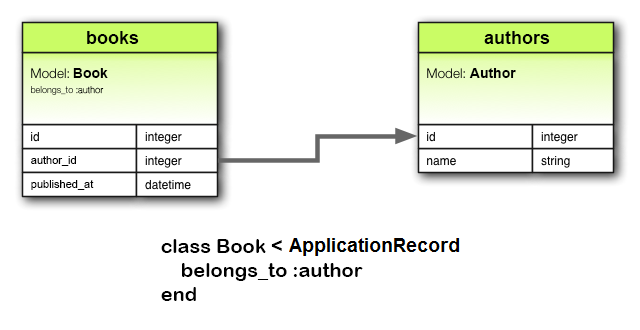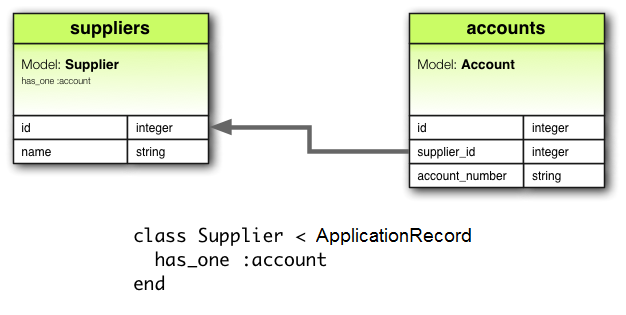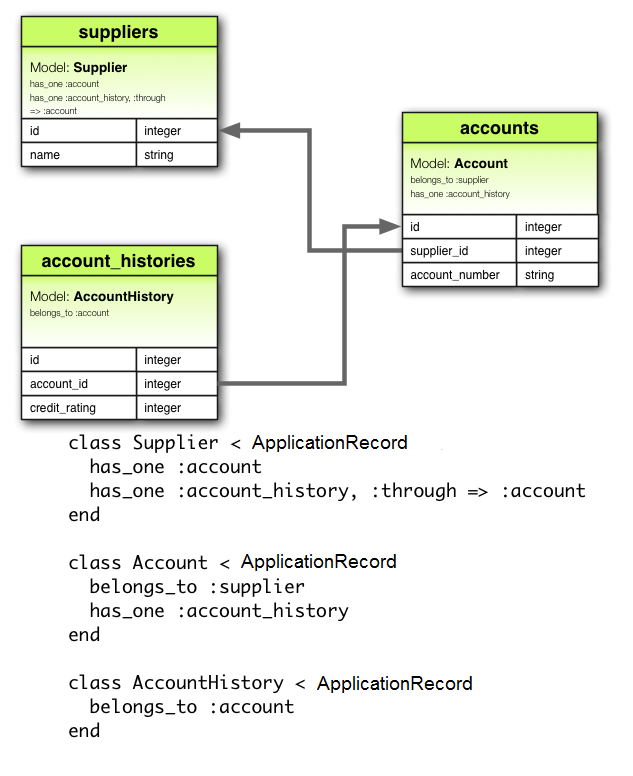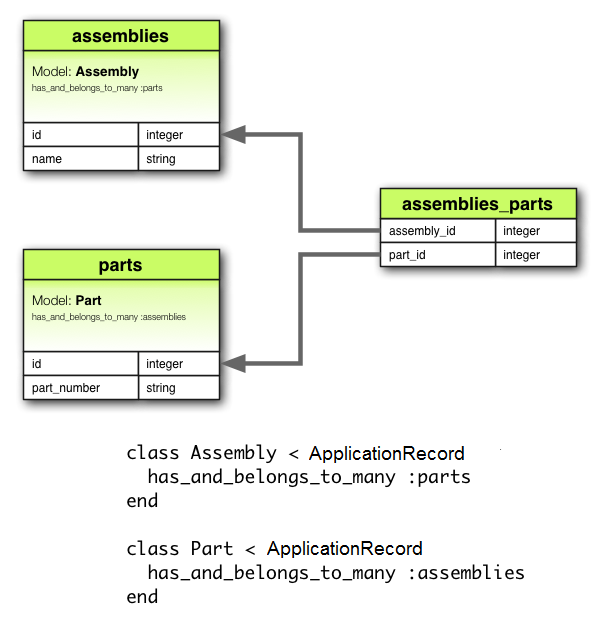Rails寶典 第三章 Models Relation
♦️ Ruby on Rails
* 前情提要:我把我所學都埋藏在這裡了 去找吧!希望能幫助到新手!
嗨囉!大家好啊!
今天的這篇文章會跟大家分享models的關聯
寫完才發現篇幅有些大
所以下一章再來介紹 Devise 吧 !
那事不宜遲 GoGo !
✨ models表格關聯
primary_key 和 foreign_key :
再介紹有哪些關聯之前
我們先來介紹兩個重要的key
primary_key and foreign_key
primary key:
primary key 簡單來說就是一筆資料在一個表格中的地址
他們被用來辨識每筆資料
需要注意的是他可以是多個欄位的
舉例來說像下面這格表格: 而在 rails 中 就算你不寫
而在 rails 中 就算你不寫
在生出每一個表格的時候
他也預設會幫你做出一個 id 的欄位
並用 id 號碼作為 primary key
foreign key:
foreign key 是用來做不同表格之間的關聯
Rails的慣例是「要被對到的那個 Model 的名字」加上 _id
在一張表格中 可以跟很多表格有關聯性的欄位
因此很常 foreign key 不只有一個
當然也不一定要是 primary key
關聯的型別:
Rails models 有六種型別的關聯:
- belongs_to
- has_one
- has_many
- has_many :through
- has_one :through
- has_and_belongs_to_many
1. belong_to:
class Book < ApplicationRecord
belongs_to :author
end

2. has_one:
class Supplier < ApplicationRecord
has_one :account
end

3. has_many:
has_many關聯類似於has_one
不同的是和另一個模型是以一對多連線
4. has_many :through :
has_many :through關聯通常用於與另一個模型建立多對多的連線
 另外 has_many :through 在設置巢狀的has_many關聯的時候也很實用
另外 has_many :through 在設置巢狀的has_many關聯的時候也很實用
舉例來說 一個document 有多個sections
然後一個sections有多個paragraphs
並且你希望可以直接獲取document 中的paragraphs
我們就可以這樣設置:
class Document < ApplicationRecord
has_many :sections
has_many :paragraphs, through: :sections
end
class Section < ApplicationRecord
belongs_to :document
has_many :paragraphs
end
class Paragraph < ApplicationRecord
belongs_to :section
end
透過 through: :sections 我們可以直接取得paragraphs
@document.paragraphs
5. has_one :through :
跟has_many :through 是差不多的
只是這邊換成has_one
舉例子 每個供應商都有一個帳戶 每個帳戶與一個帳戶歷史記錄相關聯

6. has_and_belongs_to_many :
has_and_belongs_to_many關聯與另一個模型建立了直接的多對多連線
沒有干預模型

⭐️ 一對多 的 自己關聯自己:
有一次在我製作專案的時候
遇到了這個問題:要怎麼將models關聯自己呢?
先說說這個專案叫做 whisper 是一個前輩帶我一起做的
我們希望他可以像twitter一樣
每個tweets下可以再有很多關聯的tweet留言
在 whisper中的 buzzs 就是 tweets
我們要讓 buzz可以透過 parent_id 這個foreign_key 來關聯自己
下面是最後成功的程式碼 歡迎參考🥳:
首先是 model的設定
# models/buzz.rb
class Buzz < ApplicationRecord
belongs_to :user
has_many :buzzs, foreign_key: "parent_id"
belongs_to :parent, class_name: "Buzz", optional: true
acts_as_votable
end
# db/migrate/_add_parent_to_buzzs
class AddParentToBuzzs < ActiveRecord::Migration[7.0]
def change
add_column :buzzs, :parent_id, :integer, null: true
end
end
接著是 view的部分
<!-- 展示首頁的buzzs(沒有 parent_id 的 buzzs)-->
<!-- 檔案:views/buzzs/index.html.erb -->
<h1>Buzzs</h1>
<div id="buzzs">
<% @buzzs.where(parent_id: nil).each do |buzz| %>
<%= render buzz %>
<p>
<%= link_to "Show this buzz", buzz %>
</p>
<% end %>
</div>
<%= link_to "New buzz", new_buzz_path %>
<!-- 展示單一 buzz 的畫面(會有他的子 buzzs) 及創建child buzz 的 form -->
<!-- 檔案:views/buzzs/show.heml.erb -->
<%= render @buzz %>
<!-- render reply buzz -->
<% @buzz.buzzs.each do |buzz| %>
<div class="sub_buzz">
<%= render buzz %>
</div>
<%= link_to "Show this buzz", buzz %>
<%= render partial: 'buzzs/form', locals: {buzz: buzz.buzzs.build, parent: buzz} %>
<% end %>
<div>
<%= link_to "Edit this buzz", edit_buzz_path(@buzz) %> |
<%= link_to "Back to buzzs", buzzs_path %>
<%= button_to "Destroy this buzz", @buzz, method: :delete %>
</div>
<!-- create form for child buzz -->
<%= render partial: 'buzzs/form', locals: {buzz: @buzz.buzzs.build, parent: @buzz} %>
<!-- views/buzzs/_buzz.html.erb -->
<div id="<%= dom_id buzz %>">
<% if buzz.parent_id == nil %>
<p>
<strong>Content:</strong>
<%= buzz.content %>
</p>
<%= button_to like_buzz_path(buzz), method: :put do %>
<%= buzz.get_likes.size %>
<% end %>
<%= button_to dislike_buzz_path(buzz), method: :put do %>
<%= buzz.get_dislikes.size %>
<% end %>
<% else %>
<p>
<strong>Reply:</strong>
<%= buzz.content %>
</p>
<% end %>
</div>
<!-- views/buzzs/_form.html.erb 用來創建新 buzz的 form -->
<%= form_with(model: buzz) do |form| %>
<% if buzz.errors.any? %>
<div style="color: red">
<h2><%= pluralize(buzz.errors.count, "error") %> prohibited this buzz from being saved:</h2>
<ul>
<% buzz.errors.each do |error| %>
<li><%= error.full_message %></li>
<% end %>
</ul>
</div>
<% end %>
<div>
<%= form.label "content", style: "display: block" %>
<%= form.text_field :content %>
</div>
<% if !parent.nil? %>
<input type="hidden" name="buzz[parent_id]" value= "<%= parent.id %>">
<% end %>
<div>
<%= form.submit "Create"%>
</div>
<% end %>
<!-- views/buzzs/new.html.erb -->
<h1>New buzz</h1>
<%= render partial: 'buzzs/form', locals: {buzz: @buzz, parent: nil} %>
<br>
<div>
<%= link_to "Back to buzzs", buzzs_path %>
</div>
<!-- views/buzzs/edit.html.erb -->
<h1>Editing buzz</h1>
<%= render partial: 'buzzs/form', locals: {buzz: @buzz, parent: @buzz.parent} %>
<br>
<div>
<%= link_to "Show this buzz", @buzz %> |
<%= link_to "Back to buzzs", buzzs_path %>
</div>
今天的內容就分享到這邊啦!
下一篇文章來介紹非常厲害的 Devise
那我們下篇文章見啦!!!☺️